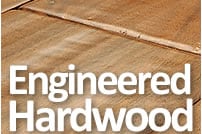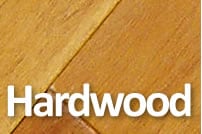Today people are ditching the carpet and installing new wood flooring in their homes. The warmth of wood has an eternal draw. So what do you buy? What does the term term wood flooring even mean?
Of all the types of wood-like flooring, laminate and engineered are the two that are most often confused. Most homeowners know that neither are considered "real wood," at least in the sense that solid hardwood is most evidently "real wood."
But often, the distinction ends there. Lumping laminate and engineered wood together is a gross misrepresentation of the two products. In a nutshell, engineered wood is most closely aligned to solid hardwood, in that its price point resembles that of solid hardwood and it does incorporate a layer of natural wood. Laminate is more of a bargain product that can look good from a distance, but does not hold up well to close examination.
Let's look at laminate flooring vs. engineered wood flooring, their relative strengths/weaknesses, then lets look at hardwood flooring. The differences go into the type of installation as well as the material. The cost is of course a concern as well....Hardwood is the most expensive. Another concern is health--there is currently a lot of concern about formaldehyde in laminate flooring......see formaldehyde in Laminate article.
Laminate
 Laminate is durable, cost-effective and comes in a variety of colors, textures and sizes.
Laminate is durable, cost-effective and comes in a variety of colors, textures and sizes.
It’s very versatile! The core of product is typically made of High Density Fiber (HDF) as opposed to actual slabs of wood. The top layer is a photographic layer which is designed to mimic the look you’re going for i.e. hardwood, bamboo, knotted wood, etc. Laminate planks are typically 3/8” thick and are installed using a tongue and groove locking system, meaning you can install or uninstall with ease.
It’s the most durable and easiest to clean (read: it can handle the most abuse).
When you walk on it, you hear a shallow tap.
Installation on concrete slab--
The boards simply interlock. You may or may not need a moisture barrier. See how-- Laminate
This is the most inexpensive method. It is not as authentic and there are currently concerns about health issues with use of this product. See formaldehyde
Engineered Hardwood
 The best way to describe engineered hardwood flooring is to think of it like a hybrid car; it’s a little bit of laminate and a little bit of hardwood.
The best way to describe engineered hardwood flooring is to think of it like a hybrid car; it’s a little bit of laminate and a little bit of hardwood.
It’s core is usually plywood or high-density fiberboard (HDF) and the top layer is composed of a of hardwood veneer which is glued atop the core to mimic nearly any species of hardwood. Engineered hardwood has the natural characteristics of the selected wood species as opposed to a photographic layer (which is what you get with laminate). The reason people tend to choose engineered hardwood over natural hardwood is garner greater moisture and heat resistance because of the core material.
Installation on a concrete slab--
Engineered wood flooring can be glued or floated over the top of a fully-cured concrete slab. The slab needs to be clean, dry and be extremely flat. But it is not necessary to first install plywood or a sleeper sub-floor system before installing the engineered wood planks (like you do for real wood). Although, you could install a sub-floor system first if preferred. See How--Engineered floor
| Engineered Wood Flooring | Laminate Flooring | |
| In Brief: What Is It? | Engineered wood flooring is made of plywood with a veneer of fine hardwood on top. | Laminate flooring is made of thin, pressed wood board with an image of wood on top covered by a clear "wear layer" to protect the image. |
| Is It Considered Real Wood? | Debatable. Certainly, the thin veneer skin on top is real wood. Yet the base layers are high-quality plywood, which is no more "natural wood" than laminate flooring's pressed wood base. | No. Even though laminate flooring is composed of a majority of wood fibers, none of this wood is in its natural state. One thing to note: there is a common misconception that laminate is made of plastic. This is not true. There is some resin in the form of the thin top wear layer, and perhaps an attached underlayment, but it is mostly made of wood. |
| Cost | Moderate to High. Expect to pay nearly as much for engineered wood as for solid hardwood. | Very Low to Moderate. Laminate flooring ranges from very cheap (about $0.50 for 6mm oak-look laminate) to moderately pricey (about $3.00 for long-plank 12mm oak-look boards). |
| Thickness | The top veneer layer ranges from .083" to .25". | The entire thickness of laminate flooring ranges from 6mm to 12mm (about .24" to .47"). |
| Refinishing and Repair | Moderate. Because of its thin veneer, engineered wood floor can be lightly refinished a few times before the veneer begins to wear down to the base plywood layers. | Poor. Laminate flooring cannot be refinished in any way. |
| Resale Value | Excellent. In the last few years, engineered wood flooring's stature has greatly increased, though still not considered on par with that of solid hardwood. | Fair. Though more and more homes are installing premium laminate, this product is still considered less valuable than engineered or solid woods. |
| Moisture Resistance | Moderate to well. Due to its dimensionally stable base layers, engineered wood flooring actually stands up to moisture better than solid hardwood. | Laminate is moderately water-resistant. If installed well so that no seams are exposed, it presents a waterproof shield. But when water infiltrates to the lower layers, it can swell up. Once swollen, the only recourse is to rip it out and install new laminate. |
| Ease of Installation | Moderate Difficulty. Engineered wood is just like solid hardwood in that it needs to be stapled or glued to sub-floor. However, it is possible to buy floating engineered flooring which rides independently of the subfloor. | Very Easy. Laminate flooring installation is often compared to that of vinyl floor tile installation. But this is not an apt comparison as laminate flooring is even easier to install because no adhesive is involved. Laminate boards "fold and lock" into each other. You will be able to install one room's worth of laminate in one day. |
| Where Can It Be Installed? | Any room of the house, except highly moisture-prone rooms such as bathrooms. | Any room of the house, except highly moisture-prone rooms such as bathrooms. |
| Comfort | Moderate. In that it is made of wood, it does not conduct cold well. Thus, the surface will feel relatively warm. | Moderate. Because laminate is thicker than vinyl and incorporates wood content, it is easier to walk on and warmer to the touch than vinyl. Introducing foam underlayment makes laminate slightly softer to walk on. |
| Best Point | The veneer of real wood--with its unique patterns and deep appearance--cannot be matched by vinyl or laminate's artificial images. | Laminate's top wear layer is extremely strong. It holds up well against sharp scratches like those obtained by sliding chairs or tables. |
| Worst Point | Engineered wood can receive only a limited number of sandings before the veneer layer wears through. | Laminate cannot be refinished. You can fill in deep scratches on a spot-by-spot basis. But should the entire surface become dull or scratched, you will need to re-install. |
Hardwood
 Hardwood floors are made from solid, natural wood and depending on the kind of floor you want, you can purchase a variety of wood species.
Hardwood floors are made from solid, natural wood and depending on the kind of floor you want, you can purchase a variety of wood species.
The entire plank is made from wood, it is the only material used in the manufacturing of hardwood floors. Modern hardwood is typically made with a tongue and groove system for easy installation . Hardwood floor is easy to sand and refinish, and requires a healthy amount of maintenance to keep them looking great. They are easier to damage than the two other floor types discussed here though, so buyer beware. Not only do they dent easier (i.e. if you walk with stilettos or drop a heavy object on the floor you’ll see dents), they cannot be left wet or else they’ll become damaged (the boards will swell and expand).
Hardwood flooring is almost always more expensive but no one can argue how gorgeous it looks or feels when you walk on it.
Installation on a concrete slab--
First thing to understand is that all 3/4" solid hardwood floors have to be nailed-down. This means you need some sort of wood substrate to nail the solid wood planks too. The National Oak Flooring Manufacturers Association recommends you either install a sleeper system or install plywood on top of the concrete slab first before proceeding with the solid hardwood flooring.
Note: Either method with raise your entire floor 2 inches or more, which can cause problems with entry doors. Also, all the additional sub-floor construction will add considerable amount of costs for both the material and labor to install the sub-flooring.
Sleeper Sub-Flooring Installation System
The sleeper system is where a coating of petroleum-based mastic is troweled onto the concrete slab and then polyurethane film on top of that. 2-1/4" wood studs are laid flat on top of the film and then another layer of polyurethane film is laid on top of that studs. The hardwood flooring is then nailed into the studs.
Plywood Over Concrete Slab
A more popular way is to lay polyurethane film over the concrete slab and then nail or screw down 5/8" CDX plywood over the film. The solid wood planks are than nailed into the plywood sub-flooring. Yet another method is after the polyurethane film is laid down and properly taped is to lay 1/2" CDX plywood of the top of the film and then lay another layer of 1/2" CDX plywood over the top if the other ply wood in the opposite direction and then nail or screw the two layer of plywood together. This prevents any fasteners from puncturing the polyurethane moisture barrier. Both the plywood sub-flooring and the solid hardwood planks need the proper gapping to allow for expansion.
The above gives you a general overview of the various methods used today. It is best to consult with your local flooring specialty retailer to determine what is best in your situation. Most solid wood flooring installation failures over a concrete slab will probably be from excessive moisture present in the room and this will not be covered by the manufacturer's warranty.



Comments(0)